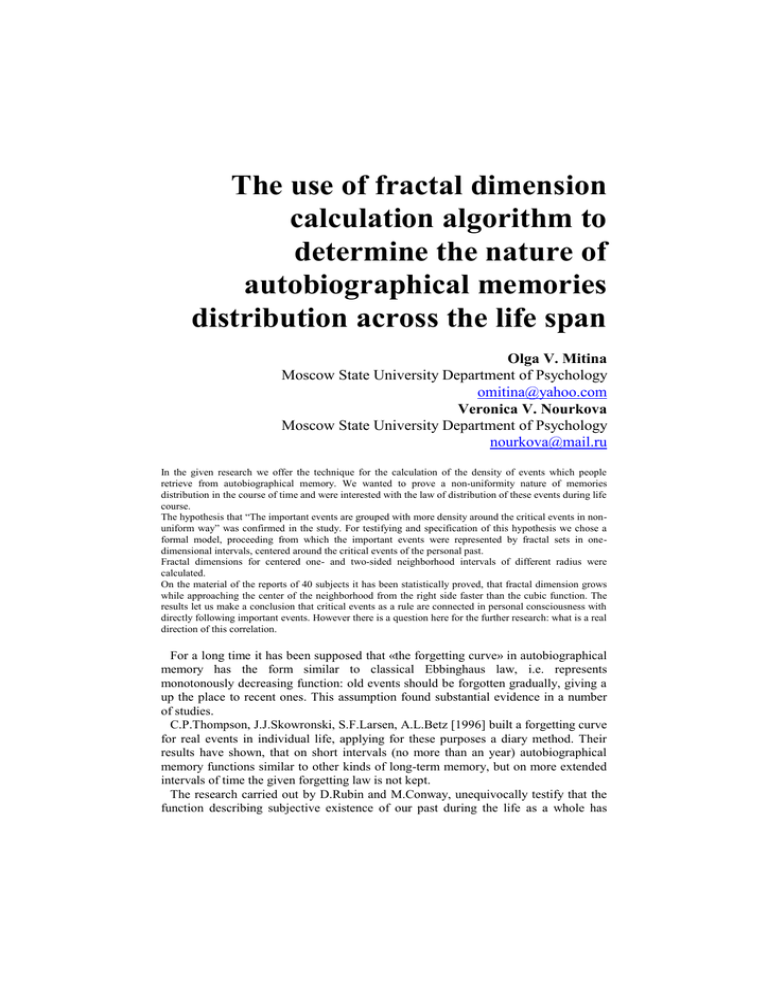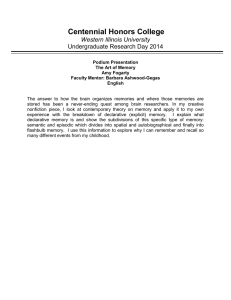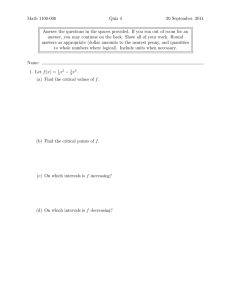The use of fractal dimension calculation algorithm to determine the nature of
advertisement

The use of fractal dimension
calculation algorithm to
determine the nature of
autobiographical memories
distribution across the life span
Olga V. Mitina
Moscow State University Department of Psychology
omitina@yahoo.com
Veronica V. Nourkova
Moscow State University Department of Psychology
nourkova@mail.ru
In the given research we offer the technique for the calculation of the density of events which people
retrieve from autobiographical memory. We wanted to prove a non-uniformity nature of memories
distribution in the course of time and were interested with the law of distribution of these events during life
course.
The hypothesis that “The important events are grouped with more density around the critical events in nonuniform way” was confirmed in the study. For testifying and specification of this hypothesis we chose a
formal model, proceeding from which the important events were represented by fractal sets in onedimensional intervals, centered around the critical events of the personal past.
Fractal dimensions for centered one- and two-sided neighborhood intervals of different radius were
calculated.
On the material of the reports of 40 subjects it has been statistically proved, that fractal dimension grows
while approaching the center of the neighborhood from the right side faster than the cubic function. The
results let us make a conclusion that critical events as a rule are connected in personal consciousness with
directly following important events. However there is a question here for the further research: what is a real
direction of this correlation.
For a long time it has been supposed that «the forgetting curve» in autobiographical
memory has the form similar to classical Ebbinghaus law, i.e. represents
monotonously decreasing function: old events should be forgotten gradually, giving a
up the place to recent ones. This assumption found substantial evidence in a number
of studies.
C.P.Thompson, J.J.Skowronski, S.F.Larsen, A.L.Betz [1996] built a forgetting curve
for real events in individual life, applying for these purposes a diary method. Their
results have shown, that on short intervals (no more than an year) autobiographical
memory functions similar to other kinds of long-term memory, but on more extended
intervals of time the given forgetting law is not kept.
The research carried out by D.Rubin and M.Conway, unequivocally testify that the
function describing subjective existence of our past during the life as a whole has
Autobiographical memories distribution
2
completely different character. The periods of subjective "emptiness" about which we
have no clear memories, and the periods of subjective "completeness", which remain
in our memory for a long period, replace each other. Reminiscence bump effect that
people recollect disproportionate high amount of autobiographical events which
happened between 16 and 26 years old was described by D.Rubin with his colleagues
in the middle of 80th [Rubin, Wetzler, and Nebes, 1986].
The found bump effect appeared to be the steadiest. Recurrence of research in six
various cultures (Japan, Bangladesh, UK, China, Spain, US) has led to comparable
results [Conway, Hague,1999].
Rubin and colleagues postulated that the obtained curve is a composition of three
independent factors: 1) childhood amnesia; 2) recency factor and 3) bump effect.
Fig.1 The distribution of autobiographical memories across the lifespane [Rubin D.C.,
Schulking M.D, 1997]
At present there are several explanations of the bump effect in autobiographical
memries concerning late youth and early maturity (see review [Conway M.A.,
Pleydell-Pearce C.W., 2000]).
First, the bump effect is interpreted as evolutionary phenomenon. In opinion of the
authors adhering to that position, the "peak" of memoirs reflects the borders of the
individual reproductive period. The decrease in mnemonic abilities after the age of 30
– the age of choosing a spouse - reflects the general dynamics of fading cognitive
functions that cannot be eliminated by natural selection of individuals admitted to
reproducing. In other words, if people chose the marriage partner at a later age, the
bump would be moved to an old age as individuals with "bad" memory would have
less chances to be chosen.
The second approach explains the bump effect from the standpoint of the general
laws of memorization – the best conditions for memorization are created in the
beginning of the period of stable stimulation. It is due to the minimum of proactive
and retroactive interference resulting in the shift from unstable to stable period. As the
youth is characterized by a maximum number of changes at biological, social and
personal levels, the following years are remembered in the best way. [Nourkova,
Mitina - in press].
The third approach develops previous ideas within the framework of personal
identity formation model [Ericson, 1976]. The phenomenon of "peak" is explained by
Autobiographical memories distribution
3
needs of personal history creation as one of the results of identity achievement
[Fitzgerald, 1988], with formation system of self-descriptions implanted in particular
memoirs during the given age period [Neisser, 1988], with the period of “the first
experiences”, which are stamped in memory because of their novelty and emotional
saturation [Shum, 1998] .
One more approach comprehends the bump effect as a result of assimilation of
cultural life scenarios [Rubin, Berntsen, in press]. By life scenario the authors mean a
representation of typical "schedule" of life events shared by all representatives of a
cultural community. Thus 6 from 7 most frequently mentioned events of these
scenarios fall into the age of 16-30 years. From this point of view the bump effect
represents a realization of the mechanism of structurization of the acting
autobiographical information according to universal rules of the organization of life
scenarios.
As we see, all above mentioned explanations insist on universal character of the
bump effect in autobiographical memoirs. However, in our opinion, there are reasons
to believe that behind the universal causes of bump effect there are also individual
causes. Proceeding from functional understanding of autobiographical memory, it is
possible to assume that preservation of high "density" of memoirs from the period of
the past happens in case when a person gets into a situation which can be named
conditionally «diachronic disunity» [Lampinen et al., 2003].
The given situations are marked in autobiographical memory as memoirs about
critical events [Nourkova, 2000; Nurkova, Vasilevskaja, 2003; Nourkova, Bernstein,
Loftus in press]. Critical event as a special type of unit of the organization of
autobiographical memory structure has critical importance and causes reorientation of
the subject from the assimilation of the events from an external world to the
accommodation to these new events, breaking the continuity of usual existence (from
«I change the world» to «the World changes me»). The main difference of critical
event from simply important one is that in the second case we interpret the life
situation, and in the first – the person himself (herself). While the important events
exist in autobiographical memory in the context of life history, critical event
determines the history of personal changes. Critical events qualitatively and sharply
modify the self-estimation in various fields of activity, the representation of the
psychological qualities, the self-image. The structure of autobiographical memoirs
about critical event is based upon substantial comparison of two systems of selfdescriptions, occurring at different times, in their relation to the point of discontinuity.
The subject should answer the question “What is me?”, “Who am I” again and again,
being based on the reference to memoirs about the events of cardinal personal changes
that happened in this period.
As it comes from general speculation about memory, the period following the
critical event is the beginning period of subjective stability. It seems to be reasonable
to predict that the period following qualitative shift in personal development will be
the most available for both voluntary and involuntary recollections. It means that each
person has his/her own unique configuration of recollective “bumps”, which reflect
the time followings critical experiences.
Autobiographical memories distribution
4
Therefore, it is possible to assume, that the individual sequence of "bumps" of a
saturation of autobiographical memory repeats in itself the configuration of critical
events of personal life.
Thus, the primary goal of our empirical research is an attempt to answer the question
whether the bump effect has individual character connected with the individual
configuration of critical events. The hypothesis to be tested is formulated as follows:
The important events are grouped around the critical events in non-uniform way.
Critical events are condensed points in this geometric structure.
3. Method
3.1 Participants and procedure
For carrying out the experimental research the «Line of a life» technique based on
the reference to the events of the already lived part of the life, revealing a schematic
image of the past as a way of personal movement along the axis of time has been used.
The subject is offered to draw an arrow, symbolizing life as a vector of time directed
from the past in the future, and the particular events of the past.
In the instruction the respondent was offered first of all to draw «a vector of
destiny», «only those events without which your life would not be yours, without
which it could not come true», and then one more form was given with the request «to
specify the events which changed your personality, made you different». Thus among
the set of events some are allocated as important (specified in the beginning), and
critical (specified in the second stage).
As a rule the number of important events was about 20 and the number of very
important, critical ones was no more than 7.
40 examinees took part in the research. Among them were 29 women (mean age was
24.4; in the range of 18-47 years) and 11 men (mean age was 29.7; in an interval of
19-62 years). Education: high school graduates – 3; some college degree – 27; MA (or
equivalent) – 10.
3.2 Technique
For testifying and specification of this hypothesis we chose a formal model,
proceeding from which the important events were represented by fractal geometrical
structures in one-dimensional intervals, centered around the critical events. Testifying
and specification of the main hypothesis about non-uniform distribution of important
autobiography events, how they are presented in personal memory and what is their
thickness around critical events can be made by calculation of Fractal dimensions of
different parts of this geometrical structure (Sprott, 1993) (for all subjects) and further
statistical confirmation of difference between empirical indices and theoretical values
which could be expected in the case of uniform distribution.
With this goal we offered the following way of calculation. For each subject all his
or her course of life was marked by critical events. In the neighborhood of each
critical event the system of centered intervals which lengths correspond among
themselves as
1 1 1
: : was constructed. (See fig.2)
2 3 4
5
Autobiographical memories distribution
Time interval « 1 » the event number
2
n
Time interval « 1 » the event number
3
n
Time interval « 1 » the event number
4
n
Tn–1
Time of the critical life
event number n-1
1
2
n
T T
1
3
n
1 1
1
1
Tn+1
Tn
4 3
2
4
n n n Time of the critical life
n
Time of the critical
event number n+1
life event number n
T
T T T
Complete interval of the critical event
Fig 2. The diagram of the partitioning of the number
intervaln of life course around critical event
number n
Table of symbols:
1
Tn2 Tn
(T Tn 1 ) ; 14
(Tn Tn 1 ) ; 13
(T Tn 1 ) ;
Tn Tn n
Tn Tn n
3
2
4
Analogically
1
Tn2 Tn
(Tn 1 Tn ) ; 13
(Tn 1 Tn ) ; 14
(T
Tn )
Tn Tn
Tn Tn n 1
2
3
4
1
1
1
1
In the Figure 1 intervals T 12 ; T 12 T 3 ; T 3 Tn4 ; Tn4 can be considered
n
n
n n
as convergent centered system of intervals.
Complete interval for the event Tn is [Tn–1, Tn+1].
Complete interval for the event T1 – is [T0, T2]. T0=0 (the moment of personal birth).
If the subject during experiment session mentioned N critical events, then complete
interval for the event TN is [TN–1, TN+1]. TN+1 – actual subject’s age.
It should be noticed that distances (measured in years) between different critical
events are not equal, so the limits of centered intervals are not symmetrical around the
center – the corresponding critical event.
Let designate the number of important event which happened during the time period
1
1
2
(time interval) Tn2 ; Tn2 as S n , the number of important event which happened
1
1
during the time interval T 3 ; T 3 as
n
n
S3n , and the number of important event which
1
1
4
happened during the time interval Tn4 ; Tn4 as S n . If important events happened
uniformly during the life course not depending upon (approaching/moving away from
the points of) critical events, then the number of events which belong to each centered
interval and happened there were in the same ratio as the intervals’ lengths.
6
Autobiographical memories distribution
3
4
S 4n
1
, S n 2 0.667 , S n 3 0.75
(*)
0.5
2
S 2n
3
4
S 2n
S3n
If we accept the hypothesis that the frequency of important events is higher near
critical event, the ratio between the numbers of events from each time interval should
be different.
If we admit than the density of important events increases linearly during
approaching to the critical event (that means that while approaching to a critical event
people more often memorize important events which happened in their life during that
time), then the ratio will be the following:
1
S 4n 7
S3n 20
S 4n 63
k
=0.583,
=0.741,
=0.788
(
Sn 2 Cxdx )
S 2n 27
S3n 80
S 2n 12
1
1
(**)
k
If we admit theoretically that the density of important events increases in
concordance with the quadratic law while approaching to critical event, then the ratio
will transform:
1
S 4n =0.661, S 3n =0.804, S 4n =0.822
S 2n
S 2n
S 3n
(S
k
n
2 Cx 2 dx )
(***)
1
1
k
For cubic model it will be:
S 4n =0.729, S 3n =0.856, S 4n =0.851
S 2n
S 2n
S 3n
1
(S
k
n
2 Cx 3 dx )
(****)
1
1
k
Thus in any model different from uniform (which we will call basic) the ratios
between indices
S kn
are always higher than corresponding basic ratios.
S ln
So to test our hypothesis that subjective representation of important events in
personal memory is not uniform and has points of thickness in the neighborhood of a
critical event we should test the fact that the set of indices computed for all subjects
and their corresponding means are higher than the basic ones.
So for each subject i we compute the sets of empirical indices
S 4n
2 ,
Sn i
S 3n
2 ,
Sn i
S 4n
3 for all Ni critical events during life course of this subject,
Sn i
that’s mean that n belongs to the range from 1 to Ni and then we get average values
Ni
Ni
Ni
S4n
S3n
S4n
S2 Si3 S2 Si4 S3
Si4
n 1 n , i2 n 1 n , i3 n 1 n
i2
S
Ni
S
Ni
S
Ni
7
Autobiographical memories distribution
And then we compute means for data sets {
S i4
S i2
}, {
S i3
S i2
}, {
S i4
S i3
} and using
statistical T-test test the hypothesis that empirical means are significantly higher than
the predicted theoretical means of the uniform model (*).
Besides, we were interested to investigate not only for two-side intervals, when the
critical events were situated in the centers of the analyzed intervals, but also for so
called right- and left- one-side intervals. In the case of left-side intervals we compared
the frequencies of important events which had happened only before the
corresponding critical event and in the case of right-side intervals we compared the
frequencies of important events which happened only after. The procedure of indices
computation was the same as for tow-side intervals, but from the logical point of view
the interpretation of results should be changed. In the case of two-side intervals the
proof of non-uniformity can testify just the correlation of facts: a person regards an
event as critical and high-density important events in the same time period are
connected with each other. In the right-side case the increasing density of important
events near the critical one, but after it, testifies that after the critical event happened
(in some way we can say that the personality has changed) all around it is considered
more sharply, from the new standpoint. The person memorizes more events and
regards events which follow the critical one as important.
Here we should remember the statement mentioned above that the beginning of
stability is memorized best of all.
In the left-side case we can assume that the increase in the frequency of important
events in the life course happens not accidentally and a person him or herself
(consciously or unconsciously) builds this sequence, and realizing or not realizing
prepares for a critical event which should happen according common life scenarios.
4
3
4
Let designate corresponding indices as L S n , L S n , L S n for left-side case and as
S 2n
S 2n
S 3n
4
3
4
R S n , R S n , R S n for right-side case. The Table 1 presents results of analysis of
2
2
3
Sn
Sn
Sn
empirical data using the suggested method.
As shown in the table in all three cases – two-side, left- and right- one-side intervals
- the hypothesis about the uniform and linear distribution of the frequencies of
important events happening in the course of life can be rejected with the probability to
make error less than 0.0005. Testing the hypothesis about the quadratically increasing
frequency of important events while approaching to a critical event the probability to
make error having rejected H0 hypothesis for two-side intervals increases a little, but
no more than 0.05. So rejection H0 still is possible for all intervals’ types.
Testing the hypothesis about cubically increasing frequency it is possible to say that
for two-side intervals H0 hypothesis is confirmed, for left-side intervals the increasing
numbers of important events as approaching to a critical event is a little higher and for
right-side intervals the statement that the decreasing frequency of important events is
going more faster than the cubic function is possible with the probability of error less
than 0.0005.
8
Autobiographical memories distribution
In general it should be noted that the above mentioned trends demonstrate more
contrast in case of right-side intervals, that’s why we can make conclusion that critical
events as a rule are connected in personal consciousness with directly following
important events. However there is a question here for the further research: what is a
real direction of this connection. Is each critical event the reason for the whole
sequence of the important events, or for an explanation of the whole cascade of the
important events, so that the person tries to find in his or her life some «trigger»,
consciously or unconsciously, in a retrospective way and then call it the critical event.
Table 1. Results of the statistical analysis for the ratios of frequencies of
important events
Test for rejection H0-hypothesis about
Means St.Dev uniform
linear
quadratic cubic
distribution distribution distribution distribution
Testable
value= 0.5
Two-side
intervals
Right-side
intervals
Left-side
intervals
Testable
Testable
Testable
value=0.583 value=0.661 value= 0.792
S 4n .7454 .16245 9.553*** 6.308*** 3.296** .631
S 2n .8883 .12121 20.262*** 15.914*** 11.877*** 8.305***
.7804 .17728 10.002*** 7.029***
4.268***
1.826*
Testable
Testable
Testable
Testable
value=0.667 value= 0.741 value= 0.804 value=0.856
Two-side
intervals
Right-side
intervals
Left-side
intervals
S 3n .8475 .14224 8.039*** 4.747*** 1.924*
S 2n .9177 .10925 14.528*** 10.242*** 6.566***
.8680 .12741 9.995***
Testable
value=0.75
6.319***
3.167**
-.376
3.571***
.599
Testable
Testable
Testable
value= 0.786 value= 0.822 value= 0.852
Two-side S 4 .8822 .13144 6.360*** 4.556*** 2.917**
1.459
n
intervals
3
Right-side S n .9564 .08558 15.253*** 12.482*** 9.966*** 7.725***
intervals
Left-side
.9022 .12666 7.599*** 5.727*** 4.027*** 2.513**
intervals
Level of significance of rejection H0 hypothesis by T-test *** – p<0.0005,
** – p<0.01, ** – p<0.05
4. Acknowledgments
This work was supported by a grant from the Russian Foundation for Basic
Research. The authors wish to thank Igor Timofeev for his help to translate this text in
English.
Autobiographical memories distribution
9
References
Conway, M.A. , Hague S., 1999, Overshadowing the Reminiscence Bump: Memories
of a Struggle for Independance. Journal of Adult Development, Vol.6, No 1, 35 –
44.
Conway, M.A., & Pleydell-Pearce, C.W., 2000, The construction of autobiographical
memories in the self-memory system. Psychological Review, 107, 261-288.
Ericson E., 1976, Youth and crisis.
Fitzgerald, J. M., 1988, Vivid memories and the reminiscence phenomenon: The role
of a self narrative. Human Development, 31, 261-273.
Lampinen J.M., Odegard T.N., J.K.Leding, 2003, Diachronic Disunity. In D.R.Beike,
J.M.Lampinen, D.A.Behrend (Eds.) The Self and Memory. New-York.
Neisser, U., 1988, Commentary. Human Development, 31, 261-273.
Nourkova V.V., 2000, Past Continuous: Psychology of Autobiographical Memory,
Moscow: University Publishing House. (in Russian)
Nourkova V.V., Bernstein D.M., Loftus E.F. Biography becomes autobiography:
Distorting the subjective past and present through story completion . Journal of
American Psychology. Manuscript in press.
Nourkova V.V., Mitina O.V. Is it really that we remember about youth more than
about other life periods? About universality bump-effect in the autobiography
memory. In press.
Nourkova V.V., Vasilevskaya K.N., 2003, Autobiographical memory in challenging
life situation: New phenomena, Voprosy Psihologii, N 5, p. 93 – 102.
Rubin, D.C., Berntsen, D., Cultural Life Scripts Structure Recall from
Autobiographical Memory. In press.
Rubin, D.C., Wetzler, S.E., & Nebes, R.D., 1986, Autobiographical memory across
the adult lifespan. In D.C. Rubin (Ed.), Autobiographical memory, pp. 202-221.
New York: Cambridge University Press.
Rubin, D.C., & Schulkind, M.D., 1997, Distribution of important and word-cued
autobiographical memories in 20, 35, and 70 year-old adults. Psychology and
Aging, 12, 524-535.
Shum, M.S., 1998, The role of temporal landmarks in the autobiographical memory
processes. Psychological Bulletin, 124, 423-442.
Sprott, J., 1993, Strange Attractors: Creating Patterns in Chaos, New York: M&T
Books.
Thompson C.P., Skowronski J.J., Larsen S.F., Betz A.L., 1996, Autobiographical
Memory: Remembering What and Remembering When. Lawerence Erlbaum
Associates, Inc., Publishers, Mahwah, New Jersey




